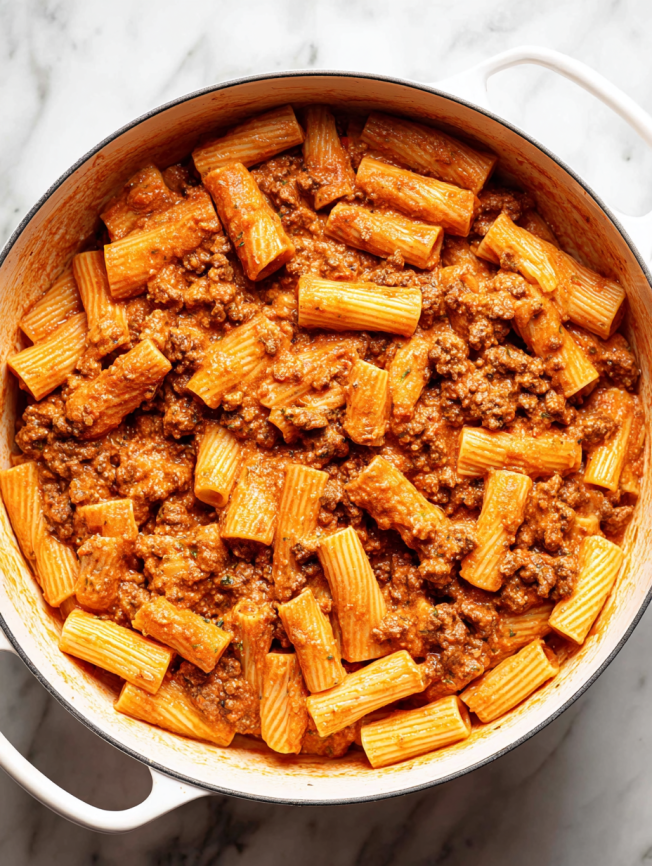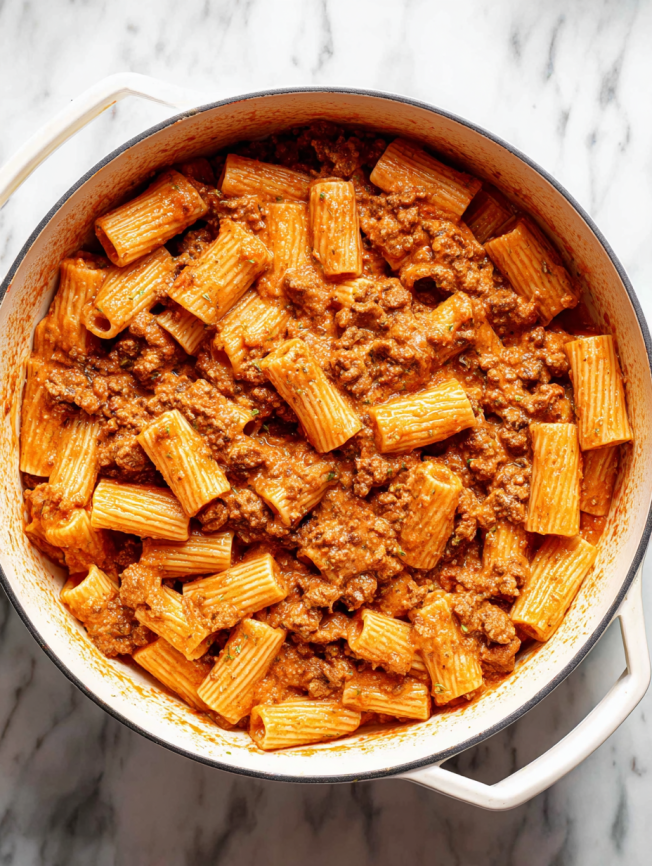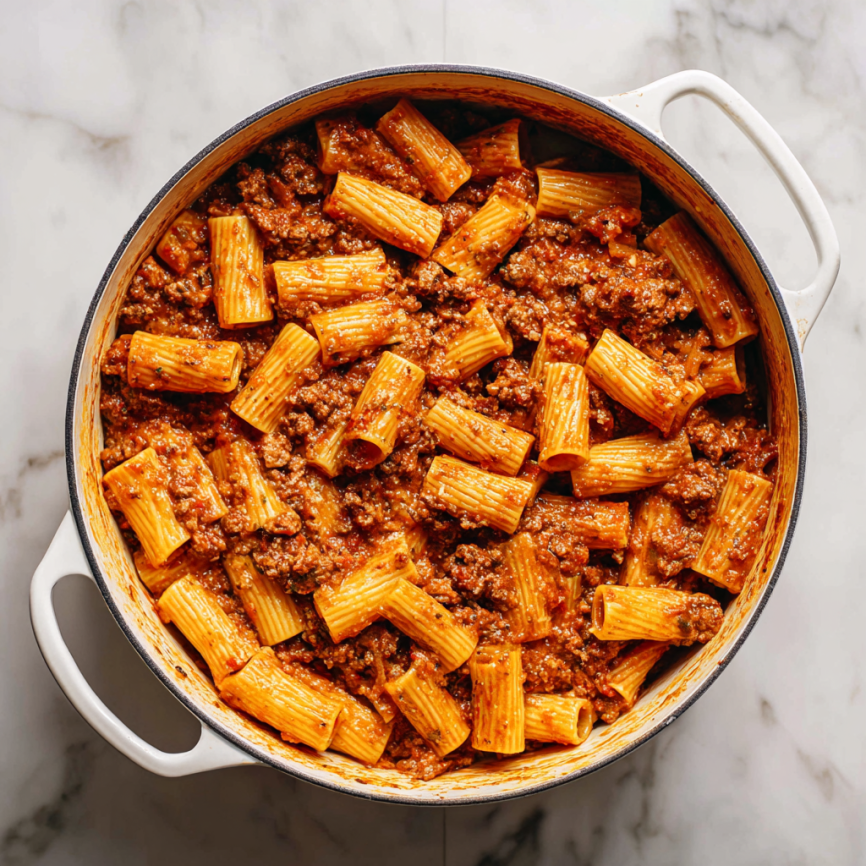There’s something profoundly satisfying about a pasta dish that delivers all the rich, robust flavors of traditional Italian cooking without requiring hours in the kitchen or a pantry full of exotic ingredients. This sausage rigatoni recipe has become my family’s answer to those hectic weeknight moments when everyone craves something hearty and comforting, but time is in short supply. As someone who believes that great Italian food is built on simplicity and quality ingredients rather than complexity, I’ve fallen in love with how this dish proves that point beautifully.
What makes this recipe truly special isn’t just its impressive speed – though getting restaurant-quality pasta on the table in 20 minutes is certainly remarkable. Instead, it’s how each simple ingredient plays a crucial role in building layers of flavor that taste like they’ve been developing for hours. The combination of savory Italian sausage, aromatic garlic, and fresh basil creates that authentic Italian flavor profile that feels both familiar and satisfying.
Why This Recipe Will Transform Your Weeknight Dinners
Authentic Italian Simplicity
This recipe embodies the Italian philosophy of letting high-quality ingredients shine through careful technique rather than overwhelming them with unnecessary additions. Using just a handful of pantry staples and fresh ingredients, you’ll create something that tastes genuinely Italian.
Family-Friendly Appeal
The combination of tender rigatoni tubes, savory sausage, and creamy tomato sauce appeals to both adults and children. Moreover, the familiar flavors make this an excellent introduction to Italian cooking for picky eaters while still satisfying more sophisticated palates.
Weeknight Speed with Weekend Flavors
In just 20 minutes, you’ll have a dish that tastes like it simmered all day. The quick-cooking technique builds flavors efficiently, making this perfect for busy schedules that still demand satisfying meals.
Minimal Cleanup, Maximum Impact
Using just one pan for the sauce means minimal dishes while the pasta water reservation technique ensures restaurant-quality sauce consistency without any additional steps or ingredients.
Essential Ingredients for Italian Perfection
The Pasta Foundation
- 12 ounces rigatoni pasta – Perfect tube shape holds sauce beautifully
- 1/2 cup pasta water – The secret to silky sauce consistency
The Aromatic Base
- 1 tablespoon olive oil – Creates flavorful foundation for sautéing
- 6 cloves garlic, minced – Provides essential Italian flavor base
- 1 tablespoon Italian seasoning – Adds herbaceous complexity and authenticity
The Protein Star
- 1 pound ground Italian sausage – Delivers rich, seasoned flavor and hearty texture
The Sauce Components
- 28 ounce can crushed tomatoes – Forms the robust tomato base
- 3/4 cup heavy cream – Creates luxurious, velvety texture
- 1/4 cup fresh chopped basil + more for garnish – Adds bright, aromatic freshness
The Finishing Touches
- Shredded Parmesan for garnish – Classic Italian cheese finish
- Kosher salt and black pepper – Essential seasonings throughout
Step-by-Step Instructions for Perfect Results
Preparing the Foundation
Step 1: Cook the Pasta Perfectly Bring a large pot of generously salted water to boil – the water should taste like seawater. Cook the rigatoni according to package directions until just al dente. This timing is crucial because the pasta will finish cooking when tossed with the hot sauce. Before draining, reserve 1/2 cup of the starchy pasta water, which will be essential for creating silky sauce consistency.
Step 2: Start the Aromatic Base While the pasta cooks, heat the olive oil in a large sauté pan over medium-low heat. This gentle temperature ensures the aromatics won’t burn and become bitter during the initial cooking phase.
Building the Flavor Profile
Step 3: Create the Garlic Foundation Add the minced garlic and Italian seasoning to the heated oil. Cook while stirring constantly for 30-60 seconds, just until the garlic becomes fragrant and golden. Be vigilant during this step – burnt garlic will ruin the entire dish with bitter flavors.
Step 4: Brown the Sausage Increase the heat to medium-high and add the ground Italian sausage to the pan. Cook while crumbling with a spatula until completely browned and cooked through. This browning process not only ensures food safety but also develops rich, complex flavors through the Maillard reaction.
Creating the Sauce
Step 5: Build the Tomato Base Stir in the crushed tomatoes, heavy cream, fresh chopped basil, and several generous pinches of salt and black pepper. Cook for just a few minutes until the mixture is heated through and the flavors begin to meld together.
Step 6: Combine with Pasta Add the cooked rigatoni to the sauce along with a splash of the reserved pasta water. Toss everything together until the pasta is evenly coated with the creamy tomato sauce. The starchy pasta water helps bind the sauce to the pasta, creating that restaurant-quality consistency.
Final Presentation
Step 7: Garnish and Serve Transfer to serving bowls and garnish with additional fresh basil and generous amounts of shredded Parmesan cheese. Serve immediately while hot for the best texture and flavor experience.

Serving Suggestions That Complete the Meal
Classic Italian Accompaniments
This hearty pasta pairs beautifully with a simple arugula salad dressed with lemon vinaigrette and topped with shaved Parmesan. The peppery greens provide perfect contrast to the rich sauce, while warm garlic bread helps soak up every last drop of the delicious sauce.
Wine Pairing Options
A medium-bodied red wine like Chianti or Sangiovese complements the Italian sausage and tomato flavors perfectly. For white wine lovers, a crisp Pinot Grigio provides nice contrast to the creamy elements without overwhelming the dish.
Family-Style Presentation
Serve this pasta family-style in a large serving bowl with additional Parmesan, red pepper flakes, and fresh basil on the side. This allows everyone to customize their portion while maintaining the communal Italian dining experience.
Creative Recipe Variations
Sausage Alternatives
While Italian sausage is traditional, other proteins work beautifully in this recipe. Ground turkey seasoned with Italian herbs creates a lighter version, while spicy Italian sausage adds heat for those who enjoy more kick. Vegetarian Italian sausage provides plant-based protein without sacrificing flavor.
Vegetable Enhancements
Boost the nutritional content by adding vegetables that complement the Italian flavors. Sautéed bell peppers add sweetness and color, while mushrooms contribute earthy depth. Spinach wilted into the hot sauce provides iron and vibrant green color.
Cheese Variations
While Parmesan is classic, experimenting with other Italian cheeses creates interesting variations. Pecorino Romano offers sharper, more intense flavor, while a combination of mozzarella and Parmesan creates extra creaminess and stretch.
Heat Level Adjustments
Customize the spice level by choosing mild, medium, or hot Italian sausage according to your family’s preferences. Additionally, red pepper flakes added with the garlic provide controllable heat without changing the overall flavor profile.
Make-Ahead and Storage Solutions
Fresh Preparation Strategy
This dish is best served fresh for optimal texture and flavor, but you can prepare some components in advance. The garlic can be minced and the basil chopped earlier in the day, making the final assembly even quicker.
Storage Guidelines
Store leftover pasta in the refrigerator for up to 3 days in airtight containers. The sauce will thicken as it cools, but this actually concentrates the flavors and creates an even more delicious experience when reheated.
Reheating Instructions
Reheat gently on the stovetop over low heat, adding a splash of cream, milk, or chicken broth to restore the creamy consistency. Stir frequently to prevent sticking and ensure even heating throughout.
Freezing Considerations
While cream-based pasta dishes can be frozen, the texture may change upon thawing. For best results, consider freezing the sauce base without the cream and pasta, then adding fresh components when ready to serve.
Professional Tips for Restaurant-Quality Results
Pasta Water Magic
The reserved pasta water is crucial for achieving silky sauce consistency. The starch content helps bind the sauce to the pasta while adding body without additional thickening agents. Always save more than you think you’ll need.
Sausage Selection and Preparation
Choose high-quality Italian sausage with good fat content for the best flavor and texture. If using casings, remove them before cooking for easier crumbling and better integration with the sauce.
Temperature Control
Managing heat levels throughout cooking prevents common problems like burnt garlic or separated cream. Start low for aromatics, increase for browning, then moderate for sauce development.
Fresh Herb Timing
Add fresh basil toward the end of cooking to maintain its bright color and fresh flavor. Overcooking fresh herbs can make them taste muddy and lose their aromatic qualities.
Important Notes for Success
Pasta Cooking Precision
Cooking rigatoni just until al dente is essential because it will continue cooking when combined with the hot sauce. Overcooked pasta becomes mushy and won’t hold up to the robust sauce.
Sauce Consistency Balance
The combination of heavy cream and pasta water creates the perfect sauce consistency. If the sauce seems too thin, simmer uncovered for a few minutes. If too thick, add more pasta water gradually.
Seasoning Strategy
Season throughout the cooking process rather than only at the end. This builds layers of flavor that taste more developed and complex than last-minute seasoning additions.

Frequently Asked Questions
Can I use a different pasta shape? Yes! While rigatoni’s tubes hold the sauce perfectly, penne, shells, or any short pasta shape with ridges works well. Avoid delicate shapes that might break apart when tossed.
What if I don’t have Italian sausage? Ground beef or turkey seasoned with Italian herbs, garlic powder, and red pepper flakes makes a good substitute. You can also use regular ground pork with additional Italian seasoning.
Can I make this lighter? Substitute half-and-half for heavy cream, or use a combination of cream and chicken broth. You can also use turkey Italian sausage instead of pork for a leaner option.
How do I prevent the cream from curdling? Keep the heat moderate when adding cream and don’t let the sauce boil vigorously. If it does start to separate, whisk in a splash of pasta water to bring it back together.
Can I add vegetables to this recipe? Absolutely! Sautéed mushrooms, bell peppers, or zucchini work beautifully. Add them with the sausage so they have time to cook through and develop flavor.
What’s the best way to reheat leftovers? Reheat gently on the stovetop over low heat, adding a splash of cream or milk to restore consistency. Microwave reheating works for individual portions at 50% power.
Can I make this ahead for a party? While best served fresh, you can make this up to 2 hours ahead and reheat gently. Add extra cream when reheating and fresh basil just before serving.
Why is my sauce too watery? Make sure to drain the pasta well and use the pasta water sparingly. If the sauce is still too thin, simmer uncovered for a few minutes to reduce and concentrate.
Nutrition Information (per serving – 1/8 of recipe):
- Calories: 425
- Protein: 18.5g
- Carbohydrates: 38.2g
- Fat: 22.1g
- Fiber: 3.1g
- Sugar: 6.8g
- Sodium: 612mg
- Cholesterol: 65mg
Prep Time: 5 minutes | Cook Time: 15 minutes | Total Time: 20 minutes | Serves: 8

